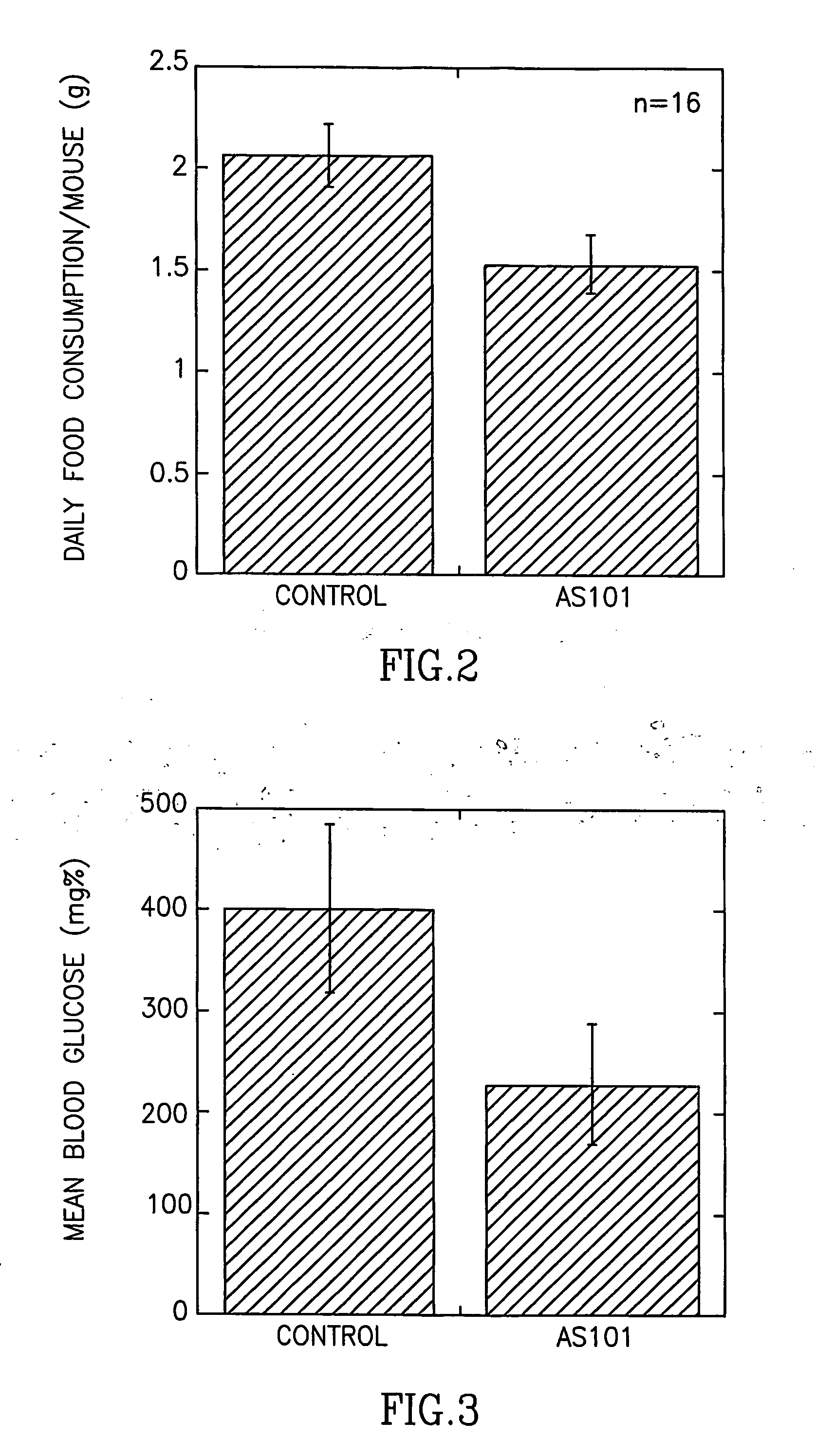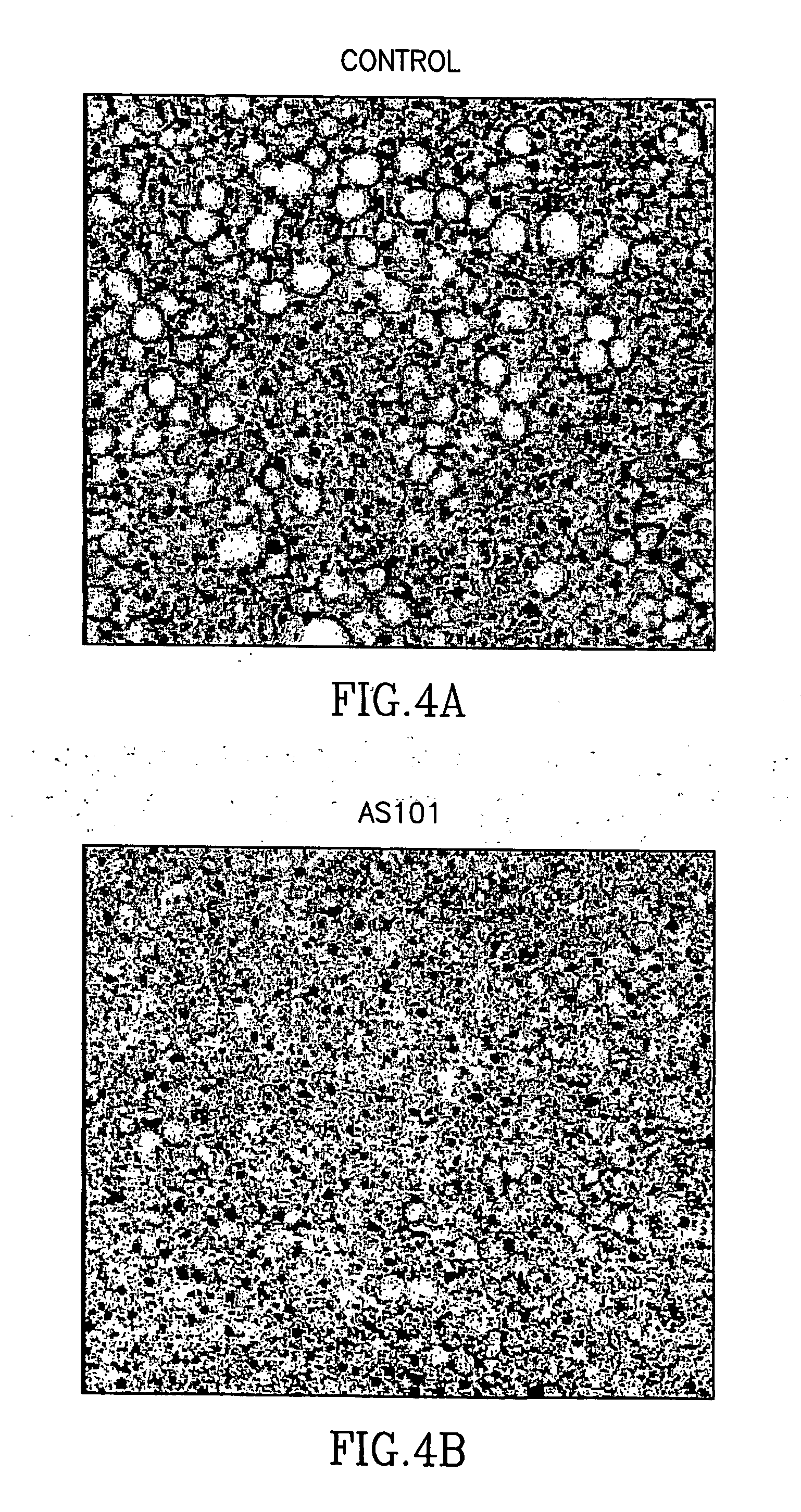Methods of treating obesity and related disorders using tellurium selenium compounds
a tellurium selenium and compound technology, applied in the field of tellurium selenium compounds for treating obesity and related disorders, can solve the problems of many people not being able to adapt to life, consuming more energy than is used by the body, and many people being overweight, etc., to reduce the blood glucose of insulin-resistant ob/ob, reduce food intake and body weight, and reduce the effect of food intak
- Summary
- Abstract
- Description
- Claims
- Application Information
AI Technical Summary
Benefits of technology
Problems solved by technology
Method used
Image
Examples
example 1
AS101 Reduces the Food Intake, Body Weight and Blood Glucose of ob / ob Mice
[0086] Female ob / ob mice (8 weeks old) were placed in metabolic cages and were given free drinking water and chow. After 48 h, one group of 3 mice (the Control group) continued to receive water and chow. A second group of 3 mice received drinking water containing AS 101 (7 mg / L) in addition to the standard chow. The experiment was continued for 18 days and body weights were measured daily. On the average the mice consumed about 1.5 ml of water per 24 h, corresponding to 10 microgram AS101 per mouse per day. This value corresponds to 0.25 mg / kg body weight per 24 h. Preliminary toxicity studies in mice have been previously shown (U.S. Pat. No. 4,764,461) an LD50 of 300 μg / 25 g of body weight in 6-week-old mice (12 mg / kg body weight); the concentration shown in the present invention to be effective is significantly lower, thus may be considered as a non-toxic concentration.
[0087] Measurement of the body weight...
example 2
AS101 Reduces Cellularity and Adipocyte Size in the Adipose Tissue of ob / ob Mice
[0089] Following 18 days treatment of the ob / ob mice with AS101 as described in Example 1, the animals were sacrificed. Samples of liver tissue were taken, fixed with formaldehyde and tissue slices were examined microscopically (FIG. 4). An extensive reduction in the number of adipocytes and in their size was obtained in liver tissues of AS101-treated mice (FIG. 4B) as compared with control mice (FIG. 4 A). This result demonstrates the efficacy of AS101 treatment in reduction of the adipose tissue.
example 3
AS101 Reduces the Body Weight of Diet-Induced Obese C57BL / 6 Mice
[0090] Since the obesity of ob / ob mice is of genetic origin, whereas obesity among human populations is largely due to excess eating over energy expenditure, the effect of AS101 on body weight was studied in diet-induced obese mice. Female mice were fed for 10 weeks with a high fat diet, resulting in moderate obesity (average weight 37 g). Mice were placed in metabolic cages and injected daily with either saline (Control group, 3 mice) or AS 101 (0.5 mg / kg body weight in saline, AS101 group, 3 mice). High fat diet was continued and the body weight was determined daily. As can be seen in FIG. 5, after an initial drop in weight due to stress in the metabolic cage the weight of the control group remained stable, whereas the weight of AS101-treated mice was reduced significantly and continued to drop through the entire study. Therefore, AS101 is an effective medicament for the treatment of diet-induced obesity.
PUM
| Property | Measurement | Unit |
|---|---|---|
| Composition | aaaaa | aaaaa |
Abstract
Description
Claims
Application Information
 Login to View More
Login to View More - R&D
- Intellectual Property
- Life Sciences
- Materials
- Tech Scout
- Unparalleled Data Quality
- Higher Quality Content
- 60% Fewer Hallucinations
Browse by: Latest US Patents, China's latest patents, Technical Efficacy Thesaurus, Application Domain, Technology Topic, Popular Technical Reports.
© 2025 PatSnap. All rights reserved.Legal|Privacy policy|Modern Slavery Act Transparency Statement|Sitemap|About US| Contact US: help@patsnap.com



